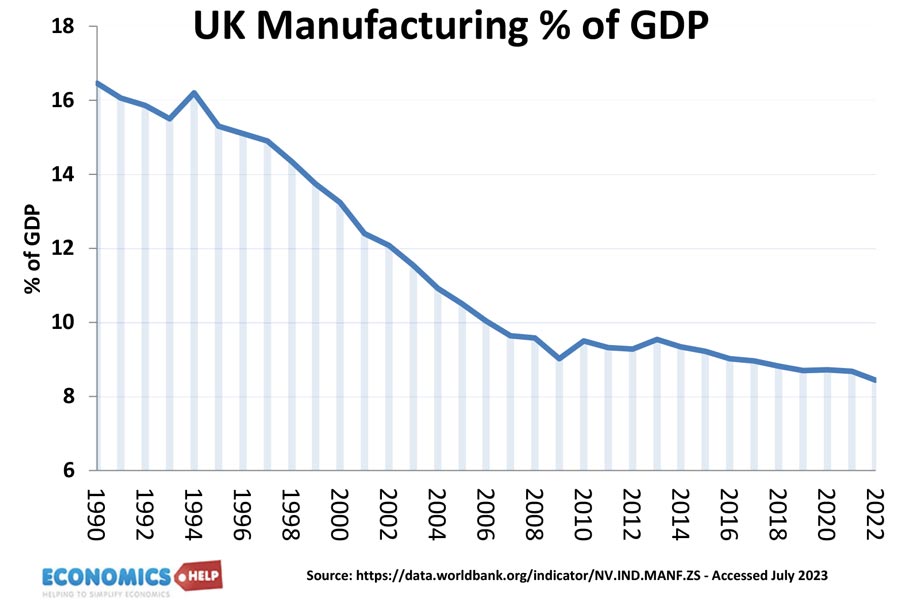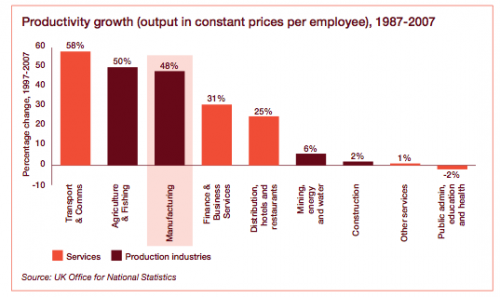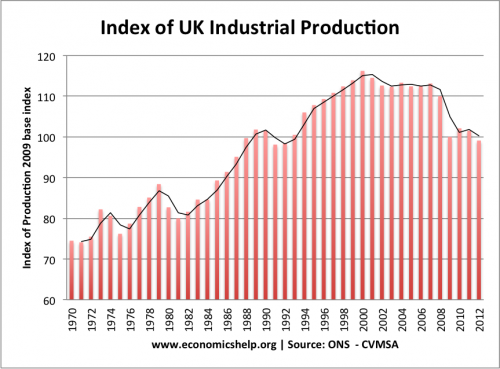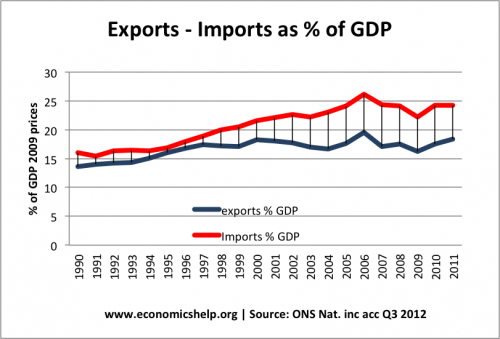The UK was the first country to industrialise, but also one of the first to deindustrialise. UK manufacturing as a a share of GDP has fallen from 30% in 1970 to 8% in 2024. The UK is not unique in smaller share of manufacturing, but the decline has been relatively bigger than other countries.

Manufacturing as a % of GDP

UK manufacturing has been in relative decline since the 1960s. Manufacturing as a share of real GDP has fallen from 30% in 1970 to 12% in 2010.

This shows that manufacturing as a share of GDP has fallen from over 32% of GDP in 1970 to 12% we see today.
Manufacturing real output
Real industrial output increased over 40% between 1970 and 2000. In June 2010 manufacturing in the United Kingdom accounted for 8.2% of the workforce and 12% of the country’s national output

Source: PWC
In 2008, the UK was still the 6th largest manufacturer by the output (source: UN Council for Trade and Development) 25% of UK manufacturing exports are high tech goods. (see what does UK produce?) In some industries, such as car production, aerospace and nuclear technology, the UK has shown strong growth in recent years. In other sectors, such as clothing and textiles, the UK has seen a sharp fall in output.
Manufacturing and industrial output
During the great moderation, industrial output growth was weak relative to the overall economy. Between 1997 and 2007, the index of real industrial output only increased from 110 to 113.

Manufacturing output (which excludes mining and primary industries) offers a similar story of low growth, but overall growth was still positive.

Manufacturing output was falling relative to real GDP growth, but it is misleading to say manufacturing was ‘halved’
Manufacturing in historical perspective
UK manufacturing has been in ‘relative’ decline since the 1960s. (other primary industries, like coal have been in decline since the 1920s)
Firstly, the percentage of jobs in manufacturing and industrial production has steadily declined. In 1980, 25% of jobs were in manufacturing. By 2010, the percentage of jobs in manufacturing had fallen to 8.2%. (though labour productivity increased substantially in this period.) In fact, manufacturing productivity has outstripped the service sector.

Source: PWC
However, the assumption of ‘relative’ decline, needs to be put into context.

This shows that manufacturing output is highly cyclical, during recessions of 1974, 1981, 1991 and 2008-09, we see a sharp fall in output.
Reasons for relative decline in manufacturing
- The decline in manufacturing as a share of GDP is a phenomenon experienced in other developed western economies. Partly, this reflects rising real wages, meaning comparative advantage shifts away from labour-intensive industries to higher tech and service sector based industries
- Fall in relative productivity. Manufacturing is traditionally an important export sector. Relative wage costs and productivity are very important for determining demand and competitiveness. The UK has struggled to remain competitive with lower wage cost economies, like China. However, it is a myth to suggest manufacturing labour productivity has been falling. A study of British manufacturing suggests labour productivity rose 50% between 1997 and 2007. (Price Waterhouse & Cooper)
- Strong Pound between 1997-2007. Because manufacturing is export-led, the sector is quite sensitive to changes in the Pound. The periods of the strongest declines in manufacturing occurred during periods of a strong pound, e.g. in the early 1980s, and early 2000s The strong pound 2000-2007, perhaps held back the growth of manufacturing. However, the strong pound theory doesn’t explain the long-term decline, only temporary changes. It is also worth noting the fall in the Pound post-2008 has done little to boost growth.
- Recessions can cause hysteresis. There is concern that a deep recession can lead to a permanent loss of output, as even good firms struggle.
Trade gap and current account
One consequence of the relative decline in manufacturing is the perceived impact on explaining the UK’s current account deficit.

Exports as a % of GDP have increased from 14% to 18%, but imports have increased even more – from 16% to 24%.

However, there are many factors explaining current account deficits apart from a shift from manufacturing to the service sector, e.g. low savings ratio, high consumption, capital flows e.t.c.
To what extent is the government responsible for the decline in manufacturing?
It is difficult to evaluate the extent to which a government could reverse the long-term decline in manufacturing and trend towards the service sector.
In the 1970s, the government was more interventionist – even propping up failing industries with subsidies, but this was widely agreed to have been a failure, with government subsidy providing an excuse to avoid painful restructuring. Since the 1980s, industrial subsidies have been minimal, and it is not really suggested as a serious policy.
Labour productivity and skills. Given that the UK manufacturing has to compete in higher skilled industries, it becomes more important to have a sufficiently skilled labour force. It is frequently argued that the UK has undervalued vocational training and skills, placing too much value on academic degrees, rather than engineering which has stronger benefit to the industrial sector.
Macroeconomic policy. A criticism of UK macro policy is that has relied too heavily on consumer spending to power economic growth. As a result, the UK has often had a low savings rate, (e.g. in 2007, the saving rate had fallen to nearly 0%). This reliance on spending and a low saving rate has led to relatively low level of business investment.
Commentary
When we talk about the decline of manufacturing, it is important to bear in mind, we only mean a relative decline. Manufacturing output has increased in real terms. To some extent, there is an inevitability that manufacturing as a share of GDP will fall, and it is not necessarily desirable or possible for a government to prevent this shift in the economy. – Just as it would be impossible to have prevented the decline in the coal industry which once employed 1 million miners.
However, there is a justifiable concern that the UK economy has been ‘unbalanced’ since the early 1980s. This is reflected in a persistent current account deficit. It is worrying that despite devaluation of Pound since 2008, the trade deficit has failed to fall. By relying on consumer spending / rising house prices, it leaves the UK economy more vulnerable to boom and bust.
In the past 20 years, frequently, we hear policymakers and politicians of all sides talk about the need to improve the record of UK manufacturing. It is easy to talk about the desirability of manufacturing, but in practice much harder to achieve.Also, the concept of manufacturing is changing, with some new tech industries having a closer overlap between manufacturing and service sector.
However, there are several things that can be done to aid manufacturing sector, such as:
- Ensure good infrastructure and transport which avoids congestion and market failure
- Ensure good education and training for a skilled workforce
- Avoid excessive regulation which may hamper investment and labour market.
- Reduce corporation tax rates (though this has implications for equity within the economy)
- Provide tax breaks and support to encourage R&D
US manufacturing decline

Post-war decline in US manufacturing output as a share of GDP.
Output in real terms has increased – though employment has fallen.
Sources:
Related


This is an excellent and very through piece of work. I would add that the most vulnerable sectors of the economy are always the ones at the margin of profitability and that these are are more likely to be affected by increases in employment taxes. National Insurance, for instance went up by almost 30% in the noughties. This is far more significant than corporation tax.
The over valued £ in the noughties certainly hit exporters in manufacturing more than they hit the services sector, so it is right to suggest that a more stable exchange rate, at a lower level, would have helped manufacturing.
At the end of the day it is indisputable that higher taxes on jobs and an overvalued £ hit manufacturing disproportionately.
Further, it is not easy for manufacturing to recover when there is little of it left. This is why the rebound as a result of a lower £ is more difficult, coupled with lack of demand abroad, and cheap, possibly dumped, products coming in from the far east.
In the nineties, the current account deficit was only marginally in deficit, in fact until 1998 when Gordon Brown openly abandoned any attempt at a balance. It is misleading to go back to the ‘early eighties’. The eighties deficit was part of a recession from which it could be claimed we made a full recovery.
So the noughties were a period where manufacturing suffered more than it might otherwise have done. Relaxation of banking regulations spurred that industry onward to the collapse of 2008 and the need for a huge government bail out. To this extent we can say that banking benefited from government policy in the noughties whilst the fall in manufacture was exacerbated.
Why do we need to worry about the deficit ? As its only like taking a mortgage out only its more like the German s mortgages where by its passed onto the next generation and so on we as the present mortgage holders are investing in the next generation of mortgage holders and as long as we all meet our payments on time where is the problem ? There has only been a surplus 8 times in the last 60
Years so why should we be concerned the only reason the tories ever had a surplus was because they sold everything off (that didn’t belong to them) and they used the consumer to let themselves get into debt by allowing the people the so called “Right to buy “‘this is why there are now a shortage of council houses ! Mrs thatcher also did this so it would put people in debt then they would think twice about industrial action as they would have lost their home if they didn’t pay the mortgage however in a council house it would have been different
q32 aqa paper 3 question 2017…
We currently spend more on interest on public debt (our 5th highest outgoing) than on defense or policing or transport. I don’t know whether that includes PPP. I can see that we get the benefit of capital projects before paying for them, but it we quickly be cheaper to pay fro0m taxes then reduce taxes by 5% once the debt was gone. The government mistake was to reduce taxes BEFORE paying off the debt.